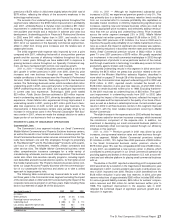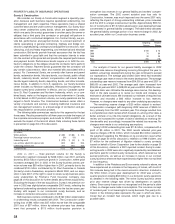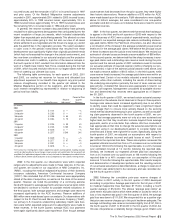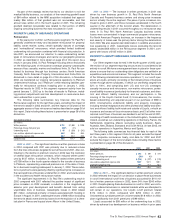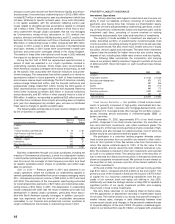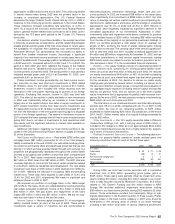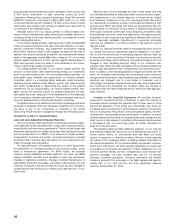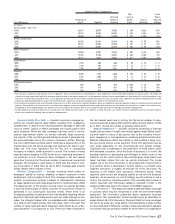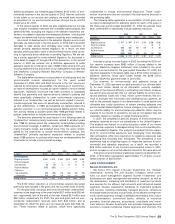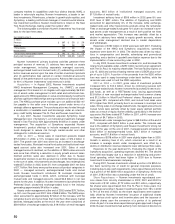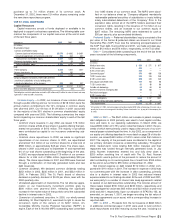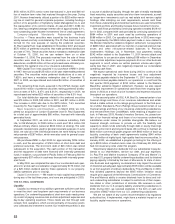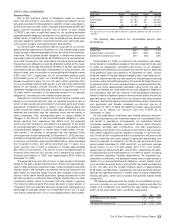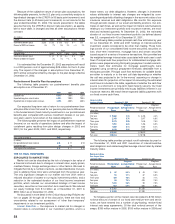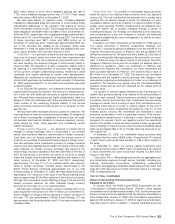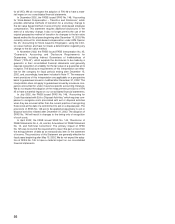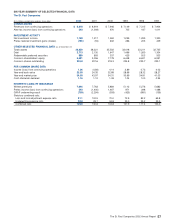Travelers 2002 Annual Report Download - page 49
Download and view the complete annual report
Please find page 49 of the 2002 Travelers annual report below. You can navigate through the pages in the report by either clicking on the pages listed below, or by using the keyword search tool below to find specific information within the annual report.
Number of Claims / Supplements(1)
Paid Losses
Dismissed Losses on Paid on
Pending as of Settled, or Settled Costs to Pools and
Line of Business: Dec. 31 Reported Resolved Claims Administer Related
($ in millions)
General Liability – Non E & A
2002 38,217 68,807 70,802 $ 643 $ 263 N/A
2001 40,212 70,540 68,384 $ 526 $ 234 N/A
2000 38,056 70,280 67,098 $ 521 $ 250 N/A
Workers’ Compensation
2002 35,731 51,604 54,300 $ 381 $ 57 N/A
2001 38,427 56,084 55,368 $ 374 $ 57 N/A
2000 37,711 55,081 58,768 $ 304 $ 55 N/A
Medical Malpractice
2002 12,862 8,271 10,635 $ 831 $ 190 N/A
2001 15,226 18,706 18,897 $ 834 $ 206 N/A
2000 15,417 9,337 10,952 $ 671 $ 194 N/A
Environmental(2)
2002 1,275 449 633 $ 34 $ 15 $ 9
2001 1,459 390 1,317 $ 34 $ 11 $ 14
2000 2,386 405 1,662 $ 15 $ 12 $ 11
Asbestos(2)
2002 3,923 1,757 1,093 $ 187 $ 31 $ 14
2001 3,259 1,096 929 $ 13 $ 22 $ 10
2000 3,092 1,226 1,277 $ 9 $ 12 $ 10
Assumed Reinsurance(3)
2002 N/A N/A N/A $ 1,150 $ 44 N/A
2001 N/A N/A N/A $ 825 $ 29 N/A
2000 N/A N/A N/A $ 736 $ 18 N/A
(1) The claim counts included in this table represent counts of “supplements,” which are extracted from our actuarial databases. A claim supplement is the finest level of detail recorded in our statistical systems. For example, two
claimants for a single general liability bodily injury occurrence would be counted as two separate supplements. Our claim department manages claims on a policyholder basis, while the data in this table is presented on a claim
count basis. For environmental and asbestos claims, a claim supplement count does not reflect the number of claimants involved on the account. For asbestos claims, supplements are generally created based on the number
of policy years potentially implicated on the account. For environmental claims, supplements are generally created to track the number of sites involved on the account.
(2) The environmental and asbestos claim count information includes only losses on direct written business whereas the paid loss data on assumed business, presented separately, includes loss and defense and cost containment
expenses. Claim count data is not shown on losses assumed from other companies and/or insurance pools because we are often either covering a very small portion of any one claim, or a number of claims which are com-
piled together as one for reporting purposes and, therefore, such statistics would not be meaningful. Also, the costs to administer these claims do not include adjusting and other related payments.
(3) Includes property and casualty loss experience since casualty only is not available. Also, claim counts are not available on assumed reinsurance. Loss settlement amounts include defense and cost containment expenses
whereas costs to administer include only adjusting and other related payments.
The St. Paul Companies 2002 Annual Report 47
General Liability (Non-E&A) — Includes insurance coverage pro-
tecting the insured against legal liability resulting from negligence,
carelessness, or failure to act causing property damage or personal
injury to others. Claims on these coverages are usually paid to third
party claimants. While we offer coverage that may result in low-fre-
quency, high-severity claims (i.e. excess umbrella, large accounts),
the majority of the non-E&A general liability business is generally sta-
ble and predictable due to the volume of business written. Although
the cost of administering these claims comprises a large portion of the
overall claim cost, the actual average loss payment per claim is gen-
erally low. The most significant risk for this line is unexpected
increases in inflation, either economic or social. The number of newly
reported claims dropped in 2002 driven by an underlying decrease in
our exposure to loss. Premiums have increased in the last several
years due to pricing, but the actual number of exposures insured has
dropped. The increase in paid dollars in 2002 was the result of clos-
ing more claims in 2002 than we did in 2001. Average paid severity
trends remain within industry norms.
Workers’ Compensation — Includes insurance which covers an
employers’ liability for injuries, disability or death to persons in their
employment, without regard to fault. The coverage provided under the
workers’ compensation policies is based on state-specific schedules
for wage replacement and medical payments for injured workers.While
the largest portion of the workers insured under our policies generate
a very low severity body of claims, a portion of our premium volume is
generated in our Construction business center, where there is an
increased possibility of permanent and total disability requiring lifetime
payments. Although each state government can make changes in cov-
erage, the changes happen after considerable public deliberation and
very seldom will impact policies that have been sold in the past. The
number of newly reported claims dropped in 2002 driven by an under-
lying decrease in our exposure to loss. Premiums have increased in
the last several years due to pricing, but the actual number of expo-
sures insured has dropped.We closed roughly as many claims in 2002
as in 2001, driving the number of pending claims down.
Medical Malpractice — Includes insurance protecting a licensed
health care provider or health care facility against legal liability result-
ing from death or injury of any person due to the insured’s miscon-
duct, negligence, or incompetence in rendering professional services.
Medical malpractice claims are volatile in nature. While a large num-
ber are closed without a loss payment, those with payments may be
very large depending on the circumstances and judicial climate.
Significant cost is expended in the settlement of these claims, often
with favorable outcomes. Since this book of business is in runoff, the
pending inventory is decreasing and will begin to distort some of the
statistics. As the runoff matures, there will be fewer small claims and
fewer meritless claims that can be quickly dismissed. The single
largest risk in this line of business is associated with social trends in
jury verdicts which is described in further detail in our Health Care
segment discussion on pages 40 through 43 of this discussion. As
reported in the Health Care discussion referenced above, newly
reported claim counts are dropping quickly as we exit this business
segment. As we execute our runoff strategy, we will continue to see a
drop in the inventory of pending claims.The unusually high number of
claims “reported” and “dismissed, settled or resolved” in 2001 in the
foregoing table was due to the impact of the MMI integration.
Environmental — This exposure relates to general liability coverage
on policies which may be interpreted to cover environmental-related
exposures. The information presented above represents business
reported as “Not underwritten” Environmental losses as described on
pages 48 and 49 of this discussion.Payment totals for these coverages
are driven by a few very large claims, accompanied by a large number
of very small claims.While the number of new reported claims appears
to increase, they are primarily matters for which there is no expectation


